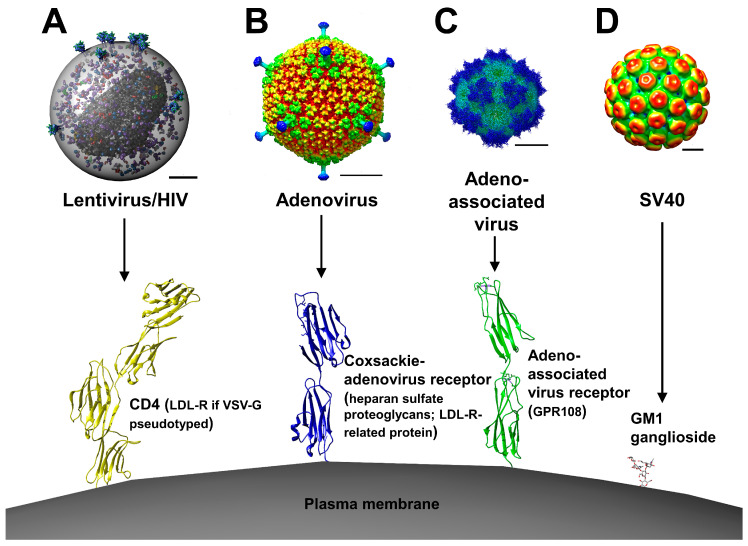Figure 1.
Viral vectors used in liver-targeted gene therapy. (A) Lentiviral vectors are able to transduce dividing and non-dividing cells and have their origin in HIV (rendered as cellPACK molecular model) [86]. HIV-based vectors bind to CD4 receptors (PDB ID: 1WIO) [87] as well as to CCR5 or CXCR4 coreceptors, mediating entry into the host cell via a cell–viral membrane fusion mechanism. Several lentiviral vectors are pseudotyped with vesicular stomatitis virus glycoprotein (VSV-G), as well as envelope glycoproteins of other vesiculoviruses, the cognate receptor of which is the low-density lipoprotein receptor (LDL-R) [16,17]. Scale bar = 300 Å. (B) Adenoviruses (EMDB ID: EMD-5538) [88] enter cells via attachment to the Coxsackie adenovirus receptor (CAR) (PDB ID: 3JZ7) [89], then attachment to αvβ3/5 integrins. Receptor attachment triggers clathrin-mediated, dynamin-dependent endocytosis, with subsequent endosomal escape, cytosolic transport via microtubules and DNA nuclear import via engagement with the nuclear pore complex (NPC). Adenoviruses can also enter the cell via CAR-independent mechanisms by binding to factor XI and factor X, then subsequent cellular binding to heparan sulfate proteoglycans (HSPGs) or the LDL-R-related protein [90]. Scale bar = 300 Å. (C) Adeno-associated viruses (EMDB ID: EMD-9012) [91] attach to cells first via HSPGs, then by engagement with the adeno-associated virus receptor (AAVR) (PDB ID: 6NZ0) [92], subsequently entering the cell via a clathrin-mediated or caveolin-mediated endocytosis mechanism, although AAVR-independent mechanisms have been postulated. More recently, a highly conserved G-protein coupled receptor, GPR108, was identified, which plays an important role in viral entry and nuclear localization [93]. Virions are then trafficked via endosomes to the trans-Golgi network, ultimately leading to escape into the cytoplasm and engagement with the NPC for nucleoplasm mobilization, followed by partial uncoating and genome release. Productive cell infection is dependent upon concomitant adenovirus or herpesvirus infection. Scale bar = 100 Å. (D) Simian virus 40 (SV40) (EMDB ID: EMD-5187) [94] binds to the cell membrane via attachment of its surface VP1 pentamer to GM1 ganglioside (PDB ID: 3BWR) [95], with subsequent caveolin-dependent endocytosis and targeting the endoplasmic reticulum (ER) via endosomal trafficking. In the ER, viral capsid destabilization via the reduction of disulfide bonds leads to ER membrane penetration and viral escape into the cytosol. It is unclear whether the viral capsid disassembles prior to or after engagement with the NPC. Scale bar = 100 Å. Virus–receptor interactions are not to scale. All images rendered using UCSF Chimera [96].

